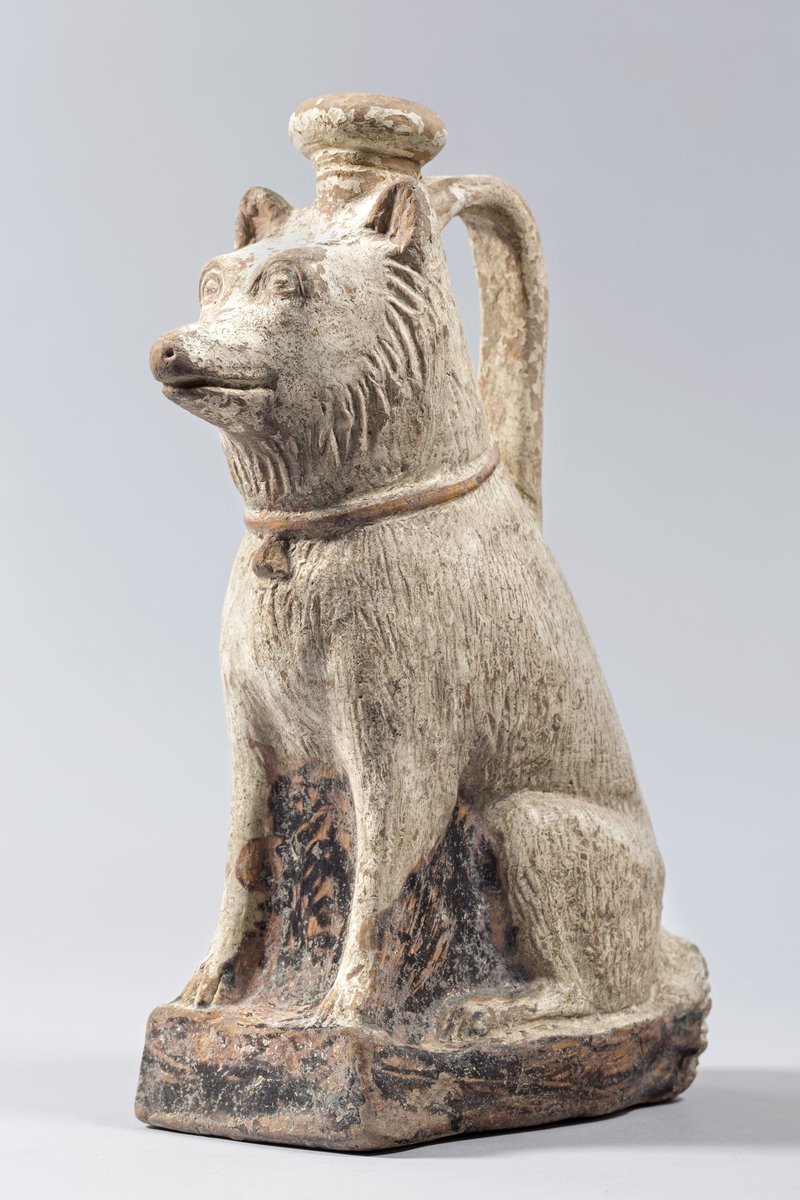
Jug in the Shape of a Sitting Dog
Classical Antiquities
| Date | 4th century B.C. – 1st century A.D. |
|---|---|
| Object type | sculpture |
| Medium, technique | carved, alabaster |
| Dimensions | height: 25.5 cm, width: 9.8 cm, depth: 11 cm |
| Inventory number | 2002.2.A |
| Collection | Classical Antiquities |
| On view | Museum of Fine Arts, Basement Floor, Classical Antiquity, The ancient Mediterranean |
The southwest corner of the Arabian peninsula roughly corresponds to present-day Yemen and is rich in mountains and plains suited for agriculture. It was an area that the Greeks believed to be fabulously wealthy, at least after Herodotos’s account in the 5th century B.C. Based mostly on scanty information, it was dubbed ‘Fortunate Arabia’ from the 3rd century B.C. Roman authors also referred to it as Felix or Beata Arabia, and distinguished it from the desert region, Arabia Deserta, which occupied most of the peninsula. The Mediterranean peoples attached great importance to ‘Fortunate Arabia’, since it was the sole supplier of frankincense, as well as of myrrh, cinnamon, other scents and spices, and special types of wood. South Arabian traders transported gold, silver, ivory, and tortoise-shell from Africa, as well as treasures from India.
Ancient Greeks and Romans embarked late and infrequently on expeditions to the area. Its discovery was equally slow in modern times. Researchers during the 18th and 19th centuries were interested merely in its inscriptions, and systematic excavations only began in the 1950s. However, during the last two or three decades several countries have commenced large-scale archaeological research there, especially after the merging of the region’s two historically different parts into the Republic of Yemen in 1990.
So far we can draw only a sketchy picture of the first millennium of South Arabian cultural history, and even this is uncertain in many respects, especially as regards chronology. South Arabian culture seems to have been established by tribes that moved in from the desert around 1200 B.C. and succeeded the area’s Bronze Age civilization. Its character was only acquired at the end of the 8th century, when the Sabaean Kingdom established its rule over most of the area. Sheba was the birthplace of South Arabian culture. Of the four major South Arabian kingdoms (the Minaean, the Sabaean, the Qatabanian and the Hadramawtian) it was Sheba that first witnessed use of the script, which developed in line with centuries old traditions. Consisting of only 29 consonantal signs and related to the Phoenician alphabet through a common origin, this script was in itself a masterpiece of South Arabian art.
Although from the 5th century the other kingdoms of South Arabia also gained in strength, despite internal wars the area preserved its relatively unified caravan culture until the 1st century B.C. Its economy was based on agriculture aided by monumental dams and irrigation works, as well as on the marketing of its products in Gaza, to which they were transported along desert tracks on domesticated camels. From the 8th century the country established contacts with Mesopotamia, neighbouring Egypt and, most importantly, Ethiopia. At the same time it was also characterized by a reclusion from foreigners. In the 1st century B.C., a group of Qatabanian mountain tribes settled down on the coast and established the state of Himyar. Himyar first became a rival to Sheba, then from the late 3rd century A.D. engulfed it, conquered Hadramawt and united South Arabia in one kingdom. Although in the 4th and 5th centuries A.D. Himyar was an important factor in the Near East, later it came under Ethiopian rule. It was then conquered by Sassanian Persia and in 628 joined Islam, which put an end to the ancient culture of South Arabia.
South Arabian sculpture has two distinctive branches. Bronze statuary flourishing from the very beginnings first followed the great Near Eastern models, then from the 3rd century B.C. it was patterned after Hellenistic types. In contrast, stone statuary first using limestone and then a kind of alabaster abundant in the area preserved local styles and iconographic types for almost nine centuries. These works of art clearly show the distinctive features of South Arabian art. Alabaster statuary flourished between the 4th century B.C. and the 1st century A.D. Owing to the lack of datable contexts, within this period it is difficult to determine the precise chronological order of single objects, mostly because forms were developed fairly early and continued with practically no change.
The statue of the seated female belongs among the latter group. The type existed from the beginnings of South Arabian sculpture to the end of alabaster statuary in the 1st–2nd centuries. The statue clearly shows the main characteristics of this local art: an attraction to cubistic forms and blocks, immobility, frontal view, neglect of naturalistic features and details (the legs are unarticulated supports, the lower part of the body is disproportionately shorter than the upper one, the neck is unrealistically thick, the breasts lie almost at the shoulders, the dress is smooth, the arms are separated from the body by drilled holes, the feet are unmarked). Only the face is richer in details: as opposed to the Graeco-Roman habit of painting sculptures, on South Arabian alabaster statues only the eyes show colour through inlays carved from different materials. The hair at the crown of the head was modelled from stucco or plaster, and is now indicated by a rough surface. The holes piercing the ears and – as a rare exception – also the nose, once contained metal jewellery. The statue could have been made at any time between the 4th century B.C. and the 1st century A.D.
Following JÁNOS GYÖRGY SZILÁGYI
This record is subject to revision due to ongoing research.